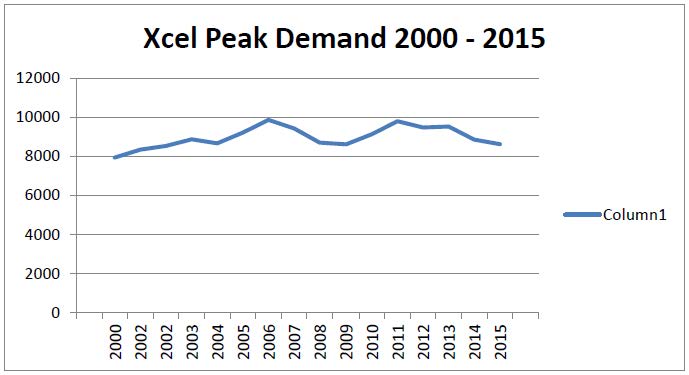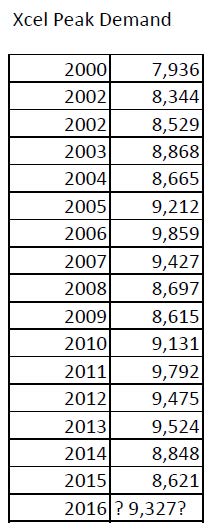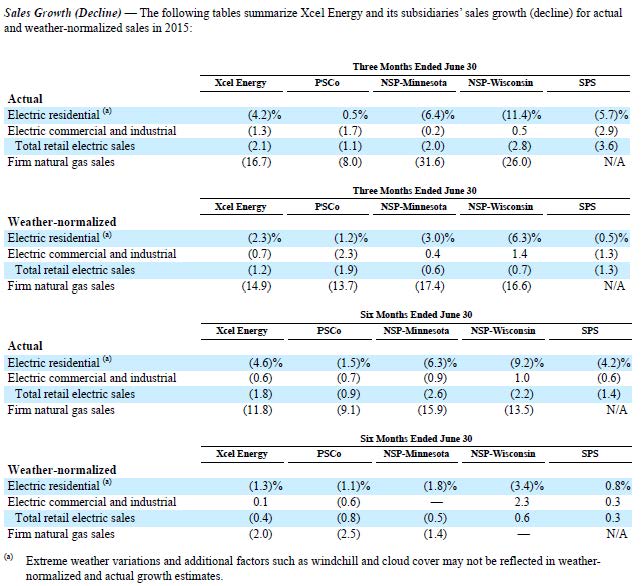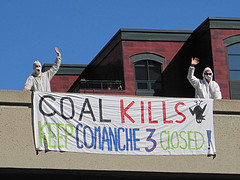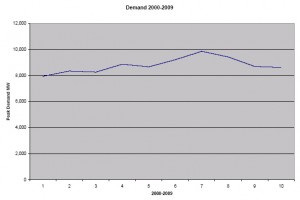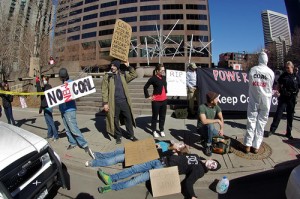Xcel’s 2015 Peak Demand
February 21st, 2016
Remember Xcel’s CapX 2020 peak demand projections of 2.49% annual increase? How wrong can they be? And how unjustified was their basis for a Certificate of Need for CapX 2020? And how are they held accountable for those gross misrepresentations? This is why the rate case in progress, PUC Docket 15-826, is so important.
I love it when this happens… Xcel Peak Demand is again DOWN! There’s a trend, and it’s called decreased demand. Demand has yet to exceed the 2007 peak, and now it’s 8 years…
Here’s the Xcel Energy SEC 10-K filed a couple days ago:
Is it any wonder they want to get away from a cost based rate a la their “e21 Initiative” scheme? Particularly now that the bill for CapX 2020 is coming due and their newest rate case (PUC Docket GR-15-826) is now underway?
And the specifics, and note how they inexplicably forecast a 2016 peak of 9,327:
Xcel Energy admits “growth” is down
July 30th, 2015
Xcel Energy’s 2nd quarter call was this morning.
Xcel Energy (XEL) Benjamin G. S. Fowke on Q2 2015 Results – Earnings Call Transcript
From the Seeking Alpha transcript, a cute tidbut:
Got that?
0.5%
That’s a ways away from the 2.49% upon which the CapX 2020 transmission build-out was based. DOH!
And about multi-year plans and why they “underperformed,” there was this snippet on the Seeking Alpha transcript:
And from our friends at Xcel:
And more:
• Xcel Energy Second Quarter 2015 Earnings Report
• Xcel Energy Second Quarter 2015 Earnings Presentation
And for those of you into charts and graphs (from the 2Q 2015 Report_1001200774):
Xcel demand down, down, down
September 28th, 2014
I’ve been saying this for so many years, that electric demand is down, down, down, and instead, Xcel Energy (and all the others) have been saying it’s going UP, UP, UP (even though Mikey Bull said years ago that they wouldn’t need power for a while), and they’re applying for and getting Certificates of Need for all these permits for utility infrastructure that are obviously designed to market and sell the surplus, and the Public Utilities pretends to be oblivious (I say “pretends” because I cannot believe they’re that unaware and uninformed.).
This is a must read:
Here’s the short version from Xcel:
2024 is expected to be about what it was back in 2007, the industry peak year. DOH! But note this — there’s a “small capacity surplus in 2016.” DOH!
And given the surplus which we’ve known has been present and looming larger, that’s why they then ask for withdrawal of the Certificate of Need for the Prairie Island uprate because it isn’t needed (and really, that was just what, 80 MW or so? Or 80 MW x 2 reactors, 160 MW?). If they don’t need that small uprate, why on earth would they need so much more?
But what do I know…
Hollydale Transmission Line was clearly not needed, and they withdrew that application…
CapX 2020 transmission was based on a 2.49% annual increase in demand, and for Hampton-La Crosse in part supposedly based on Rochester and La Crosse demand numbers, yeah right, we know better, but that was their party line. Again, DOH, it didn’t add up to needing a big honkin’ 345 kV transmission line stretching from the coal plants in the Dakotas to Madison and further east, but who cares, let’s just build it…
ITC MN/IA 345 kV line — the state said the 161 kV should be sufficient to address transmission deficiencies in the area, but noooooo, DOH, that wouldn’t address the “need” for bulk power transfer (the real desire for the line).
Here’s a bigger picture of the bottom line (I’m accepting this as a more accurate depiction, not necessarily the TRUTH, but close enough for electricity), keeping in mind that these are PROJECTIONS, and that they’re adding a “Coincident Peak adjustment” which should be included in the “peak” calculations):
Notice the only slight reduction in coal capacity, just 19 MW, nuclear stays the same, a 320 MW decrease in gas, a 128 MW reduction in Wind, Hydro, Biomass, which I hope includes garbage burners and the Benson turkey shit plant , slight increase in solar of 18 MW, and Load Management also a slight increase of only 80 MW. This is Xcel Energy with its business as usual plan, which has to go. We can do it different, and now is the time.
Will someone explain why we paid so much to uprate Monticello, and paid to rebuild Sherco 3?
From the archives:
500+ give LS Power a piece of their mind
October 20th, 2009
2012 NERC Long Term Reliability Assessment
May 7th, 2013
PJM Demand is DOWN!
November 15th, 2012
Transmission? It’s NOT needed!!!
October 18th, 2012
Xcel shelves projects, admitting demand is down
December 3rd, 2011
Demand so low PJM cancels RPM auction
March 2nd, 2010
Demand is down, down, down, though PJM is going to make us wait until March 11 to see the 2009 State of the Market Report for the full year… boooooooo-hisssssssssssssssssss.
But this little snippet did show up in a web update list:
Sent: Thur 02.04.2010 1:01 p.m.
Subject: 2011/2012 Second Incremental Auction CancelledPlease direct any questions to the RPM Hotline at rpm_hotline@pjm.com.
So the good news is that PJM is now admitting that “the 2010 RTP peak load forecast for the 2011/2012 Delivery Year is lower than the peak load forecast used in the 2011/2012 Base Residual Auction.” The bad news is that with the RPM auction canceled we will not have new numbers for energy efficiency and Semand Side Management, all those things that they are saying cannot possibly do the job that their planned pet transmission projects can. Funny how that works. And this is the kind of thing that needs to be very, very public — demand is so far down that it’s lower than their forecast used! hee hee hee hee
I love it when the market decides!
Xcel’s 10-K and a die-in!
February 26th, 2010
***********************************************
I just got a tip on what looks like a great book:
The Grid: A Journey Through the Heart of Our Electrified World
***********************************************
XCEL’s 2009 10-K just came out, and demand is down, down from 2008, but unfortunately not all that much… maybe next year!
And that, folks, is Xcel’s peak demand, from 2000 through 2009.
Now, if someone will only tell me how to label the X axis… I cannot figure it out. “1” is 2000, “2” is 2001, etc…
And about that die-in, hot off the “press” from Ted Nace:
Local Citizens ‘Die-in’ at Xcel HQ in Coal Protest
Group calls on Xcel to Keep Comanche 3 Closed and Produce 100% Renewable Electricity by 2020
February 26, 2010
Denver, CO – At 11:45am on Friday, February 26th, local citizens demonstrated at the Denver headquarters of Xcel Energy – located at the corner of 17th St. and Lawrence St. – in protest of the utility’s impending plan to bring a new coal-fired power plant online in Pueblo, CO. The lunch hour protest called on Xcel executives to move Colorado in the right direction by keeping the Comanche 3 coal-fired power plant closed. Protestors demonstrated in a ‘die-in’ in front of the building’s main entrance to highlight the grim consequences that coal has on our lives and those of future generations. Simultaneously, two activists clad in hazmat suits dropped a banner off an adjoining bridge on Lawrence St. Police arrived on scene but no arrests were made.
The 750-megawatt Comanche Unit 3 would be the largest coal-fired power plant in the state, surpassing even the mammoth Cherokee coal plant in North Denver. “At a time when the costs of coal are becoming increasingly clear and the benefits of clean energy are ever more apparent, building the largest coal-fired power plant in the state is taking us 180 degrees in the wrong direction,” said Amy Guinan, an activist with Power Past Coal.
According to Xcel’s own data, the Comanche 3 plant would emit over 20 million pounds of CO2 a day, 2 pounds of mercury a week and thousands of tons of particulates and haze forming pollutants every year. The plant would also consume over 4 million gallons of water a day.
“Xcel has already wasted nearly $1 billion on this planet-destroying boondoggle. Operating it could cost ratepayers billions more. For the sake of Colorado’s children, and future generations, it is time for Xcel to pull the plug on this ill-conceived coal plant and redirect their investments towards making Colorado 100% renewable,” said Tom Weis, President of Wind Power Solutions.
Xcel has had ongoing problems bringing the plant online. While Xcel originally hoped to bring the plant into operation last fall, a variety of technical problems – currently involving a boiler pump – continue to push back its scheduled opening.“There are a lot more than just technical problems with this new coal-fired power plant. There are serious social, economic and environmental problems. Rather than talking about a delayed opening, we should be talking about a permanent closure. Instead of building a new coal-fired plant, Xcel should be investing heavily in Colorado’s abundant solar and wind resources,” said Brian Bernhardt, an activist with Power Past Coal.
Today’s protest is part of an ongoing series of actions to move Colorado beyond coal. Sparked by the failure of elected and appointed officials to take meaningful action to move rapidly to renewable energy, the Power Past Coal campaign is building a grassroots protest effort. With the Colorado Department of Public Health and Environment approving the permit-to-pollute for both the Valmont and Cherokee stations despite overwhelming public opposition, citizens are prepared to ramp up the pressure on Xcel executives, as well as Colorado politicians and regulatory agencies.
“Our leaders are failing to lead and Xcel is failing to take their responsibility seriously. Xcel should expect more protests and actions unless they start closing down coal plants and moving Colorado to 100% renewable electricity,” Kate Clark, a Power Past Coal activist.
Xcel has been challenged on multiple fronts this week. On Tuesday evening, Pueblo residents – where the new coal-fired power plant is built – raised serious concerns about high-pitched noises from the plant which are affecting people as far as nine miles away. Meanwhile, WildEarth Guardians petitioned the U.S. Environmental Protection Agency to protect clean air and the climate and overturn an air pollution permit allowing Xcel Energy to illegally pollute while operating the Pawnee coal-fired power plant.

